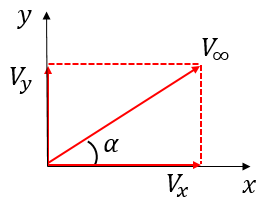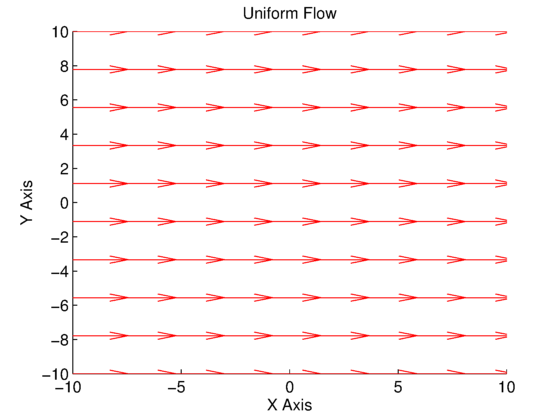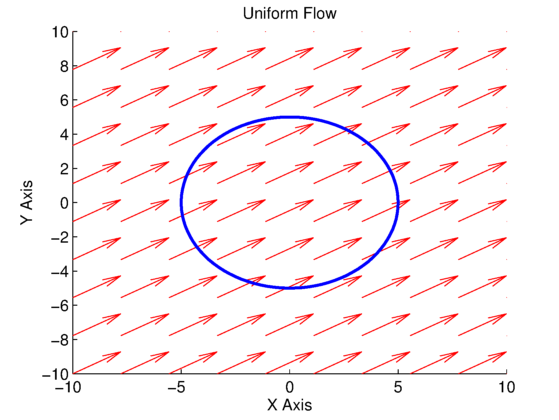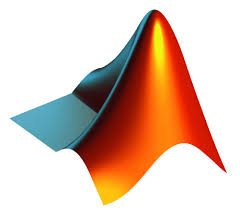For this first (and simplest) flow, our discussion will appear a little circular. That is, first we will specify the ![]() and
and ![]() velocity components of a uniform flow (at an angle of attack,
velocity components of a uniform flow (at an angle of attack, ![]() ), then we will determine the velocity potential (
), then we will determine the velocity potential (![]() ), and then we will find the velocity components from that velocity potential. The reason is just to show that we can go forward or backwards. In the remaining elementary potential flow cases, we will start with the velocity potential (we won’t derive it) and find the
), and then we will find the velocity components from that velocity potential. The reason is just to show that we can go forward or backwards. In the remaining elementary potential flow cases, we will start with the velocity potential (we won’t derive it) and find the ![]() and
and ![]() velocity components.
velocity components.
Our uniform flow needs to be, well, uniform. That is, the velocity (magnitude and orientation) needs to be the same at every point in the flow. This means that we can specify the magnitude and orientation once, and it will be the same for every (![]() ,
, ![]() ) point in the flow. Let’s define the magnitude as
) point in the flow. Let’s define the magnitude as ![]() , and the orientation as
, and the orientation as ![]() , which can take any value from
, which can take any value from ![]() to
to ![]() radians (
radians (![]() to
to ![]() ). This means we can get the
). This means we can get the ![]() and
and ![]() components of the velocity vectors (see Fig. 1) using the following equations.
components of the velocity vectors (see Fig. 1) using the following equations.
(1) ![]()

From the definition of the velocity potential, we know the following.
(2) 
This means we can integrate the velocity we defined with respect to the appropriate variables (![]() for
for ![]() and
and ![]() for
for ![]() ).
).
(3) 
We can find the velocity potential by noting that the first term in the first equation is a function of ![]() (
(![]() ), and that the first term in the second equation is a function of
), and that the first term in the second equation is a function of ![]() (
(![]() ).
).
(4) ![]()
Now we will come full circle and find the velocity components from the velocity potential.
(5) 
Note that these are the same as the velocity components we defined at the beginning of this section, and that makes sense. If they were not the same, then we would have known that we made a mistake in our integration when solving for the velocity potential. We can see that the velocity components are independent of ![]() and
and ![]() , which means they will always be the same over the entire grid. Let’s put this to practice in the code below. The two knowns that we are specifying are the velocity magnitude and velocity angle.
, which means they will always be the same over the entire grid. Let’s put this to practice in the code below. The two knowns that we are specifying are the velocity magnitude and velocity angle.
% Velocity magnitude and angle
Vinf = 1; % Velocity magnitude
alpha = 0; % Velocity vector angle [deg]
% Create the grid
numX = 10; % Number of X points
numY = 10; % Number of Y points
X = linspace(-10,10,numX)'; % Create X points array
Y = linspace(-10,10,numY)'; % Create Y points array
% Solve for velocities
Vx = zeros(numX,numY); % Initialize X velocity
Vy = zeros(numX,numY); % Initialize Y velocity
for i = 1:1:numX % Loop over X-points
for j = 1:1:numY % Loop over Y-points
Vx(i,j) = Vinf*cosd(alpha); % X velocity (Eq. 5)
Vy(i,j) = Vinf*sind(alpha); % Y velocity (Eq. 5)
end
end
% Plot the velocity on the grid
figure(1); % Create figure
cla; hold on; grid off; % Get ready for plotting
set(gcf,'Color','White'); % Set background to white
set(gca,'FontSize',12); % Labels font size
quiver(X,Y,Vx,Vy,'r'); % Velocity vector arrows
xlim([min(X) max(X)]); % Set X-axis limits
ylim([min(Y) max(Y)]); % Set Y-axis limits
xlabel('X Axis'); % Set X-axis label
ylabel('Y Axis'); % Set Y-axis label
title('Uniform Flow'); % Set title
The results of the code can be seen in the plots in Figs. 2 and 3. In Fig. 2, the angle of the velocity vector is zero (aligned with the ![]() -axis), while in Fig. 3, the angle of the velocity vector is
-axis), while in Fig. 3, the angle of the velocity vector is ![]() . We can see in both plots that the velocity vectors at every grid point are the same (uniform), and do not depend on their
. We can see in both plots that the velocity vectors at every grid point are the same (uniform), and do not depend on their ![]() and
and ![]() locations, which is what we expected.
locations, which is what we expected.

 .
.
 , and blue line for line integral to compute circulation.
, and blue line for line integral to compute circulation.In Fig. 3, the blue line represents the curve that we are computing the circulation along (see my circulation post). The line integral (and code) from my circulation post is used to calculate the circulation, which is equal to ![]() . This is expected that the circulation is nearly zero, since there is no vortex in the flow
. This is expected that the circulation is nearly zero, since there is no vortex in the flow

You will need the COMPUTE_CIRCULATION.m function in the same directory in order to run this script.


You will need the COMPUTE_CIRCULATION.py function in the same directory in order to run this script.
Note: I can’t upload “.py” files, so this is a “.txt” file. Just download it and change the extension to “.py”, and it should work fine.

Note: I can’t upload “.py” files, so this is a “.txt” file. Just download it and change the extension to “.py”, and it should work fine.
